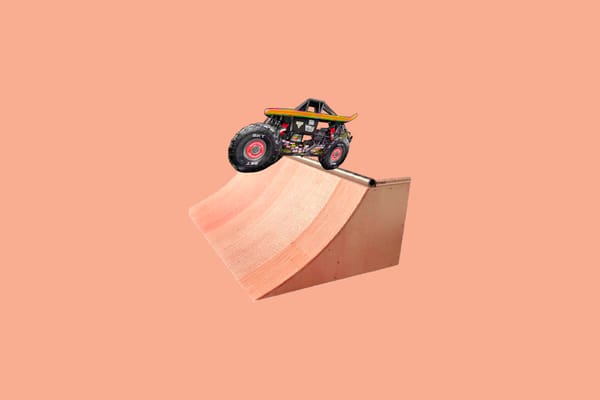Perform difficult moves with style and ease!
A look at “Street Uni X,” the world's first authentic unicycling videogame.

If lucky, we’ll experience at least one “ah-ha” moment in our lives.
That place in time a person can look back on and recognize as the source of a lifetime’s worth of passion. For the musician, it can be the particular wail of a guitar they hear over the radio. In skateboarding, the cliche of becoming hooked after seeing someone ollie up a curb for the first time is as tired as it is true. We often romanticize these moments, and for good reason. They are glimpses into new worlds. Portals that tear open our previous understanding of the way things are.
For daffodil, a Vancouver, BC-based artist and videogame designer, that moment came during a Halloween costume contest in 9th grade. A 12th grader dressed as Major Bedhead — the gregarious, neon-clad clown-cum-postie from the classic Canadian children’s television show The Big Comfy Couch — was summoned to the gymnasium stage and, in a moment of dramatic Major Bedhead flare, rode out in front of the audience on a unicycle. daffodil had never seen anyone ride one in person before and the strange mono-wheeled contraption was transfixing. Afterwards, their schoolmate let them try their unicycle, and for daffodil, that was it, their peek through the portal.
Nearly 17 years later, and after five years of production, daffodil is now months away from releasing Street Uni X (SUX), what they say is the world’s first authentic unicycling videogame. The project is an homage to the action sports games of the late 1990s and early 2000s, the ones they loved playing growing up, from Tony Hawk’s Pro Skater (THPS) to Dave Mirra’s Freestyle BMX. Like the games that inspired it, SUX merges a real and relatively unknown sport with the fantastical. The result is a game that daffodil hopes is not just fun to play but also one that shows people how dynamic the world of unicycling can be.
The clown thing is an issue.
Those goofy, rednosed caricatures have long adopted the unicycle as a part of their acts, which has painted unicycling as a circus stunt reserved for under the big top or horn-honking buskers on street corners. Over Zoom, daffodil tells me it’s an association that’s as frustrating as it is hard to break — they’ve even had strangers “doot-doot-doodle-oodle oot doot do do” at them as they’ve rode past.
For the uninitiated (likely most of us), unicycling remains that static image — a novelty, a gag. But beyond that flat public perception is an entire universe of unicycling disciplines and communities. What daffodil does and what their game is inspired by is “street uni,” the equivalent of street skateboarding, where unicyclists search out urban architecture that they can reinterpret as obstacles to ride on. You might not have thought it possible for someone to grind, slide, do flip tricks, catch air, wallride, and even perform manuals-of-a-sort on a unicycle. I didn’t either until I met daffodil. They rolled into my local skatepark, said what’s up to the folks they knew, met the side-eye of the skeptical skaters with a warm hello, and proceeded to roll into the quarter pipe and grind the entirety of the flat ledge. I had no idea what they were doing technically, but I knew exactly what they were doing conceptually.
daffodil would eventually send me video parts from street uni riders like Mimo Seedler, whose recent offering Maybe sees the German do what generations of street skateboarders have done before and continue to do: travel to Barcelona to get clips. Seedler rides at iconic spots that have long been featured in skate videos, executing astonishing moves that would otherwise seem inconceivable on a unicycle.

There’s a drive for progression in the community that takes some familiar paths to skateboarding. Minneapolis native Kyle Alviani travelled to Lake Forest, California, to become the first person on a unicycle to grind down El Toro High School’s famous 20-stair handrail. This mountainous stair set first gained notoriety thanks to the skateboarders who threw themselves down it in search of a kind of glory that offers nothing but the fondness of memory as a reward. A ghost that everyone from BMXers to scooter riders and unicyclists have chased since.
The street uni scene has also cultivated its own unique avenues. Alviani previously teamed up with Pennsylvania’s Eli Brill, a grade school teacher and two-time North American unicycle flatland champion, to release a shared conceptual video part called Brainchild. A project that mixes street and freestyle in a creative, often meandering, and overall entertaining affair. Roos Seegers, a Dutch rider, vlogs about her local scene in an endearingly positive fashion in hopes of growing the community at large. Some riders complement their street unicycling with other disciplines, like Noli Ergas, who practices muni — or mountain unicycling — which is precisely what it sounds like: a downward rush through mountain paths, along fallen trees, and hopping across boulders, all on a unicycle.
While bigger and more vibrant than you might expect, street uni and unicycling generally are still small scenes globally. In 2018, daffodil travelled to Ansan, South Korea, for Unicon, the World Unicycling Convention and Championships, an event that has been happening (mostly) biennially since 1984 and is sanctioned by the International Unicycling Federation. The Unicon website describes uni as “a sport practice including more than 35 different disciplines such as collective, individual, artistic or extreme sports” and Unicon itself as “the [world’s] biggest unicycling gathering. Each time, 1500 to 2000 participants come for a period of 12 days.” In daffodil’s experience, the attendance for the street uni events was significantly smaller than the other disciplines and lucky to reach over 100 total participants and observers. When you consider the international nature of Unicon and those numbers, it becomes apparent that its already small ridership is spread relatively thin across the globe. So much so that by daffodil’s approximation, there are only about five or six street uni riders in all of Canada.
That begs the question: is there enough of a built-in audience of unicyclists to help Street Uni X take off? And, more importantly, does that even matter? However large or small the unicycling scene is, the experience of attending Unicon and being around others who were just as passionate as them was inspiring enough that once daffodil got home from Ansan, they asked a friend for help to rig and model the first character for the game that would eventually become SUX — one creative outlet meeting another in an effort fueled purely by love.
daffodil had an idea.
While listening to “Wildlife Canada,” the soundtrack to the pseudo-documentary of the same name by anonymous vaporwave artist Eco Virtual, they wondered if they could animate the set of window blinds on the album’s cover. This thought would eventually lead to the creation of Virtua Blinds, a virtual window blinds simulator.
The game, released in 2017, was a project daffodil tinkered with in their spare time and served as a lab of sorts where they could experiment with game design. They liked the idea of Virtua Blinds being a “non-game place, just a space to exist in.” Before that came Executive Towers, the official game for the album Executive Towers by Vancouver artist Jade Statues, who daffodil met at a concert and struck up a friendship with, subsequently “cranking out the game” in a matter of months to coincide with the album’s release. The conceptual and the coincidental are strong throughlines in daffodil’s work.
With Street Uni X, that thread is years long and leads from an ersatz Major Bedhead to a Tony Hawk’s Pro Skater-inspired street unicycling game. And now, as that game is just months away from release, the question one might ask is, how is it? Well, you can purchase an early access demo of the game right now and find out for yourself. I recently loaded it onto my laptop, realized I could connect my third-party Nintendo Switch controller to my Macbook, configured it, and got rolling — mono.

The game gives you the option to run through a tutorial section, which provides you with a thorough breakdown of the gameplay functionality and the fundamentals of street uni tricks. In short order, I found myself grinding, fastplanting, and launching uni-flips over a taxi cab in a place you could describe as a digital wireframe limbo. Soon after, I was ready to give the game’s “career” mode a go. At the character selection screen, you can choose from six real-life street uni riders to play as, including Mimo Seedler, Kyle Alviani, Eli Brill, Roos Seegers, Noli Ergas, and Jack Sebben, the latter a freestyle and street uni rider originally hailing from the rural Canadian countryside.
The first of SUX’s four levels is the “Water Treatment Plant,” a nod to the industrial-style starter levels of the Tony Hawk’s Pro Skater franchise (THPS famously begins with “Warehouse,” THPS2 starts in “The Hanger,” and THPS3 opens with “Foundry”), a decision daffodil made to help get the player tuned into the action sports game genre tropes SUX lives in while still having their own spin on it. That’s followed by “Downtown,” which pulls some detail-accurate inspiration from Vancouver, blue out-of-service Translink busses and all. Next, “Indoor Park” is a riff on Heizhaus, Mimo Seedler’s home park in Leipzig, Germany. The final level, “School,” is loosely based on a schoolyard daffodil lived nearby in Vancouver’s Mt. Pleasant neighbourhood. Its digital rendering features an expansive outdoor area complete with a lazy river home to waterfowl. “CAREFUL, DUCKS LIVE HERE!!” the game scolds if you happen to pilot yourself into the drink.

The structure of SUX’s career mode is a clear tribute to THPS and other similar titles of the era. Each level has a variety of challenges to complete that unlock the next, from collecting letters that spell out T.R.I.C.K, high scores to beat, to gameplay-specific tasks that require you to do things like wallplant garage door openers and grind drinking fountains to “unclog” them. There’s even a twist on THPS’ “secret tape” challenge, which asks you to find a way to search out and connect to the level’s “WiFi hotspot.”
Each two-minute round of play kicks in with a song from a driving soundtrack that features excellent local Vancouver bands like Dumb, Necking, Never Plenty, Be Afraid, and more. After playing SUX for a few hours, I noticed a familiar feeling creeping in. A needling excitement that mirrored the countless hours of my youth spent accompanied by the screeching brass of Goldfinger’s “Superman” and angular guitar of Primus’ “Jerry Was A Race Car Driver” as I piloted a pixelated Andrew Reynolds around the “Warehouse,” attempting to string as many tricks together as possible to reach a high score.
While a cultural disconnect still exists between myself and the world of unicycling, it felt like that gap was shrinking the more I played Street Uni X, much like how Tony Hawk’s Pro Skater was my first introduction to skateboarding culture, as skewed as its presentation was in the game. But, perhaps most importantly, I was having fun. This arcadey interpretation of the sport is a blast, even if I don’t understand how to get on a unicycle IRL. Which, as daffodil told me, is part of the goal. As a kid, they were unfamiliar with skateboarding but “blown away by the holistic packaging of grungy, punk rock, and 3D aesthetic” THPS offered. It was also a game focused on “dexterity and expression,” a refreshing change from the violence that permeates videogames to this day and something they want to emulate and build on with Street Uni X, creating a space just to exist and express yourself in.
Can SUX change the hearts and minds of the uninitiated en masse in the way a game like Tony Hawk’s Pro Skater did for skateboarding? While the inspiration is clear, the comparison between the two makes daffodil wary. They’re well aware of the impact THPS has had, especially on themself, and don’t want to make any bold proclamations. But, as daffodil has shown, that “ah-ha” moment can come from anywhere — a high school costume contest, window blinds — so why not a scrappy independent videogame?
Ultimately, for them, if the people who play SUX can start to see unicycling as “a cool, expressive… athletic and artistic pursuit,” that’s success. And if the first thing that runs through their heads the next time they see a unicycle is a Mimo Seedler trick or a flashback from the “Water Treatment Plant” instead of that cursed circus song, even better.





